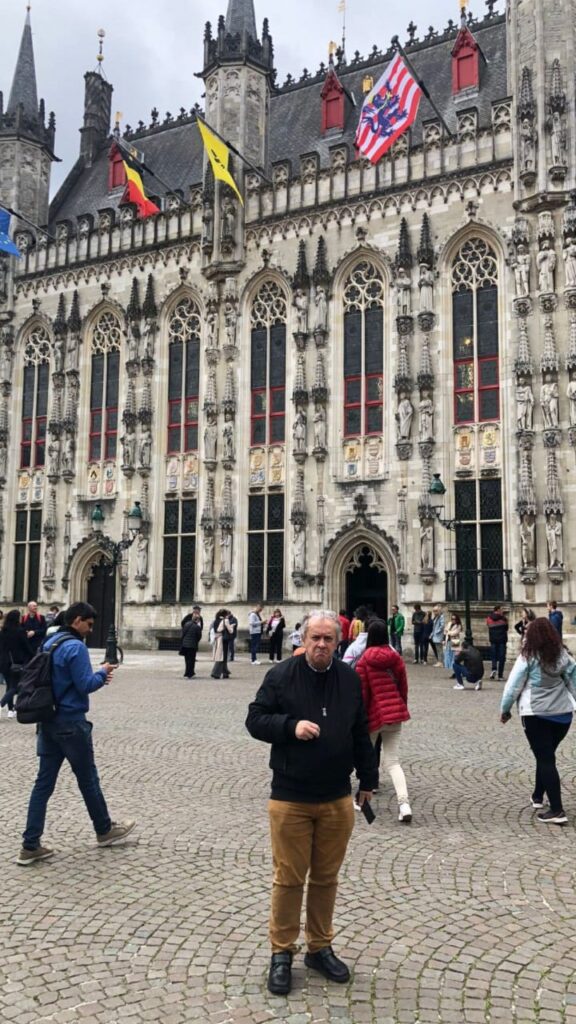By Tim Lambert
Early Belgium
The Romans conquered Belgium in 57 BC and it became integrated into the Roman Empire as Gallia Belgica. However, in the 5th century AD Roman rule collapsed and the Franks conquered Belgium. Their first capital was at Tournai. In the 9th century, the Franks ruled most of Western Europe. Yet their empire too broke up.
Then in the 11th century, Flanders (roughly modern Belgium) emerged as a powerful semi-independent realm. It also became prosperous. In the 12th and 13th centuries, the wool industry in Belgium boomed. (Cloth was manufactured using wool imported from England). Trade was also carried on with France, Germany, Spain, and Italy. Flemish (Belgian) towns such as Bruges, Ghent, and Ypres flourished.
However, the rich and powerful cities of Belgium came into conflict with the kings of France. The counts of Belgium were vassals of the French king and he was often at war with England. However, Belgium relied on English wool and the merchants were unwilling to side with the French against the English. Furthermore, the French king hoped to integrate Belgium into his realm.
Matters came to a head in 1302 when craftsmen in Bruges refused to pay a new tax. The French king sent soldiers to garrison the town. However, Pieter De Coninck, a weaver, and Jan Breydel, a butcher led a rebellion on 18 May 1302. They killed anyone who could not pronounce the Flemish words schild end vriend. The uprising in Bruges spread to the rest of Belgium and a French army was sent to crush it.
However Belgian peasants and craftsmen crushed the French at the Battle of the Golden Spurs on 11 July 1302. (The Belgians disguised a marsh with brushwood and the French knights rode into the trap). Afterward, the Belgians collected 600 golden spurs. Following the battle, France was forced to recognize the independence of Flanders.
In the 14th century, an area of what is now France called Burgundy was a powerful realm. In 1377 the Duke of Burgundy married Margaret of Flanders, the heiress of the Count of Flanders. After the count’s death in 1385 Flanders became part of the Burgundian territory. Under the Burgundian rule, trade continued to flourish. It was also a great age of achievement in art with such famous artists as Jan Van Eyck (1390-1441) and Hans Memling (1440-1494). Furthermore, Leuven University was founded in 1425.
Then in 1477 Mary, heiress of the Duke of Burgundy married Maximilian of Austria. So Belgium came under Austrian rule. Maximilian’s grandson Charles I became ruler of Spain as well as Austria and Belgium. However, in 1566 that huge realm was divided. Charles’s son Philip became king of Spain and Belgium. So Belgium came under Spanish rule.
Meanwhile, in the 16th century, the whole of Europe was rocked by the Protestant Reformation but most people in Belgium remained Catholic. Then at the end of the 17th century, the European powers fought over Belgium. In 1714 at the end of the War of the Spanish Succession Austria was given Belgium.
However, in 1794 the French army occupied Belgium. In 1795 Belgium was annexed by France. The French Revolutionaries introduced several reforms but in 1797 they also introduced conscription. The result was a rebellion in 1798 but the French crushed it and remained in control.
In the early 19th century Belgium began to industrialize. Coal mining boomed. So did textiles and the metal industries. However, in 1815 Napoleon was defeated at Waterloo. Afterward, the great powers redrew the map of Europe. Belgium and Holland were united together as one country.
However, the union was never going to work as Belgium and Holland were too different economically and culturally. On 25 August 1830 rebellion broke out and at a conference in January 1831, the great powers agreed to recognize Belgian independence.
Modern Belgium
On 21 July 1831 Leopold of Saxe-Coburg became king of Belgium and he reigned until 1865. During his reign, Belgium continued to industrialize but there was increasing tension between two language groups, Flemings and Walloons.
Leopold II reigned from 1865 to 1909. He hoped to make Belgium more powerful and in 1885 he took control of an area called the Belgian Congo. However, the Africans were treated with appalling cruelty, and in 1908 the Belgian government stripped Leopold of his control. He died in 1909 but Belgium ruled the Congo until 1960.
Belgium suffered badly during the two world wars. In 1914 Belgium was neutral but the Germans invaded anyway. The Belgians resisted valiantly but almost all of their country was overrun and the Germans treated them brutally. Belgium was neutral again in 1940 but once again the Germans invaded. However, the Allies liberated Brussels on 3 September 1944. Yet after the war, Belgium was left devastated.
However, Belgium soon recovered from the Second World War, and in 1957 it was one of the founder members of the EU. Brussels is now the headquarters of the EU. Furthermore, Belgium joined the Euro in 1999. In the late 20th century Belgium became an affluent society. Television began in Belgium in 1953.
Today Belgium is a prosperous country. In 2019 Sophie Wilmes became the first woman prime minister of Belgium. In 2024 the population of Belgium was 11.5 million.

Bruges in Belgium
Last revised 2025